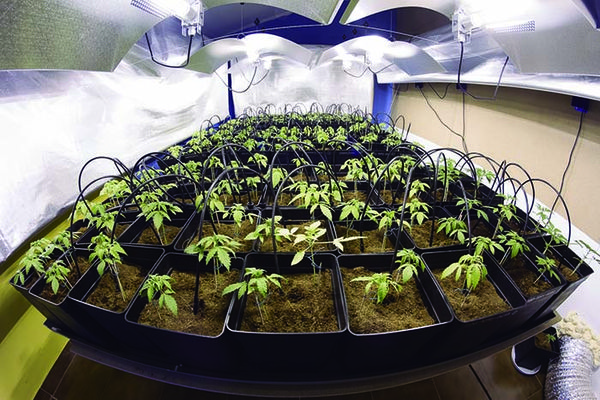- The type of bulb you choose when growing cannabis indoors is a factor of great importance to ensure your crop's success.
- Through lighting we seek to artificially recreate the ideal conditions for our beloved cannabis plants to thrive.
- Good lighting can spell the difference between wilted and unproductive plants, and sturdy, healthy ones oozing with resinous buds.
- Therefore, it is important to choose the right system. Here we tell everything you need to know about bulbs for indoor marijuana growing.

Factors to consider when choosing the type of bulb to use
- Power: In order to obtain an optimal yield from your indoor crop you will have to consider the luminescent power you are going to need. The decision is based, basically, on striking a balance between production levels and energy expenditure, with the expense that this entails. More power does mean more production, but it also leads to higher electricity bills. The most-used power level is 400w and 600w bulbs, with their corresponding ballasts.
- Heat: The more watts, the more production, but this also entails more heat. This can be a problem if your growing area is not very big, or you live in a warm climate. Of course, there are types of lighting that emit much less heat, but they have the disadvantage of being more expensive and generating lower yields.
- Space: The amount of space you have to work with is another factor to consider. If this is limited you will have to remember that it is going to heat up more easily, so you will want to avoid lamps that emit too much heat. Moreover, in a small space lower-power lights will suffice to meet your needs.
- Light spectrum: Depending on the stage in which a cannabis plant is found, a grower needs one type of light spectrum or another. For example, during the growth stage cannabis plants need blue light, while during the flowering season they require red. This is because red tones better mimic the type of sunlight that occurs in the autumn months, when cannabis naturally flowers outdoors.
Types of bulbs for indoor cannabis cultivation
HID bulbs: High-Pressure Sodium (HPS) and Metal-Halide (MH) bulbs
HID (High Intensity Discharge) bulbs are the most popular lighting option for the cultivation of indoor cannabis crops. There are two types: Metal-Halide (HM) and High-Pressure Sodium lamps (HPS). The main difference between the two is that the former provide a more bluish light, adequate for the growth stage, while HPS lamps feature a red light spectrum, ideal for the flowering period.
HPS bulbs
Although HPS bulbs are especially well suited for the flowering phase, you can also find mixed HPS (dual spectrum) bulbs that are good for the growth and flowering stages.
- Advantages: Traditionally HPS bulbs have been considered those offering the best overall performance. 600w HPS bulbs are the most popular because they offer a good balance between the amount of light that they produce and the electricity they consume. In general this type of lighting is more economical than other options, is easy to install and handle, and offers good performance.
- Drawbacks: HPS lighting features two problems: on the one hand, it produces a lot of heat and, secondly, its light spectrum is not optimal for proper growth. Moreover, bulbs over 600w give off a lot of heat, which means you need a good ventilation system in your growing room. They also wear out over time, so you will have to replace them periodically. To give you an idea, their average life span is around one year, although this can vary depending on how much they are used. Moreover, this type of bulb is not compatible with standard light sockets, so they require a special cover and a ballast, which makes them consume a lot, with the consequent increase (considerable) in your electricity bill.
Metal-Halide (MH) lamps
MH lamps are a modern version of high-pressure mercury lamps. Thanks to the mechanical components they contain, they are able to significantly improve the performance of the lamp, and they feature a more balanced spectrum. This type of bulb requires a ballast to turn it on, which is typically compatible with both MH and HPS (High-Pressure Sodium) bulbs. If you are going to use the same ballast for the growth and flowering stages, you must keep the wattage in mind: you will need to use, for example, bulbs and 600w ballasts, or 400w, etc. Those most commonly found are of 250, 400 or 600w.
- Advantages: The MH's light spectrum, very rich in blue, is great for growing cannabis plants. These light bulbs also offer excellent results during the pre-flowering phase (first 2-3 weeks of flowering).
- Drawbacks: In general MH bulbs wear out much faster than HPS ones do, so you will have to change them much more often; after every three crops, at least.
Fluorescent and CFL bulbs
Fluorescent tubes or CFL (Compact Fluorescent Light) bulbs are an ideal type of light for the early stages of the plant's growth, as at this time they require less light output. For the flowering season there are warm CFL lights, which produce a more reddish kind of light. Very simple to use, fluorescent tubes come in a bulb format, with the typical fitting for a socket. CFLs, meanwhile, have a built-in ballast, so you only have to screw them to the reflector and connect. Typically fluorescents range between 18 and 55w per tube, while CFLs typically pack 100, 125, 200 or 250w.
- Advantages: CLF fluorescents are those that produce the best blue spectrum for the vegetative phase. In addition, because they are low-consumption bulbs, they help to slash your monthly electricity bill. Thanks to their availability and low cost, this type of lighting is ideal for novice growers.
- Drawbacks: The problem with this type of lighting is that, due to its limited power, a large number of bulbs is needed to properly illuminate your crop. In addition, you must set up a system to place them closer or further away from your plants in order to ensure adequate intensity during the different stages of indoor growing, thereby increasing the space necessary for their proper installation and use.
LED bulbs
These bulbs, whose acronym refers to Lighting Emitting Diode, are gaining more and more adherents amongst cannabis growers. On the market you can find different strengths, from 90 to 280W, and even higher.
- Advantages: The reason for the great success of LED bulbs is their excellent cost-benefit ratio: their production results are very similar to those of HPS bulbs, but with the advantage that they consume much less and produce little heat. This not only results in significantly lower electricity bills each month, but also, because they are cooler, LED lights can also save you money on extractors.
- Drawbacks: their high price. Despite the considerable initial investment, it is quickly offset by significant savings on monthly electricity bills. However, their prices are so high compared to other systems that there are some growers who just can't afford the outlay. Their limited heat generation can also be a disadvantage during the coldest months of the year, so you might need to compensate by using thermal blankets to increase the temperature in your growing room. There is a very wide variety of LEDs on the market, yielding very different results.



Comments from our readers
Read comments in other languages:
Did you like this post?
Your opinion about our seeds is very important to us and can help other users a lot (your email address won't be made public).